
Original Link: https://www.anandtech.com/show/2335
Penryn and SkullTrail Benchmarked at IDF
by Anand Shimpi & Cara Hamm on September 20, 2007 3:00 PM EST- Posted in
- CPUs
November 12, 2007 is the date.
The processor? Intel's Core 2 Extreme QX9650.
The core? Penryn, 45nm, quad-core - Yorkfield if you want to get codename specific.
Over 800 million transistors, mostly used to create 12MB of L2 cache split among two die, this chip is truly a marvel and of course Intel had it at IDF.
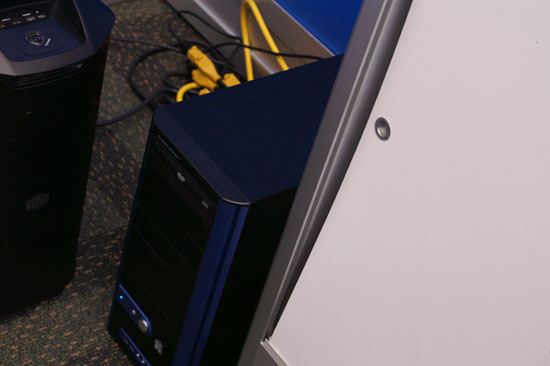
One of many X38 systems equipped with a 3.0GHz Yorkfield Penryn at IDF
There was no hiding Penryn at this year's IDF; it was in all of the demo machines, it was talked about in great detail during the technical sessions and of course, Intel let us benchmark it. As always, Intel's benchmarks were under controlled circumstances; while we ran the tests ourselves Intel already knew the outcome.
We've already previewed the dual-core version of Penryn, codename Wolfdale. The clock-for-clock performance improvement isn't bad, as we're looking at a range of 5 - 10% increase in performance over Conroe.
Intel had a couple of notebooks setup, featuring mobile-Penryn vs. Merom. Intel let us run a couple of SSE4 benchmarks, both video encoding specific, to showcase some of the best case scenario performance improvements you can expect to see in notebooks.
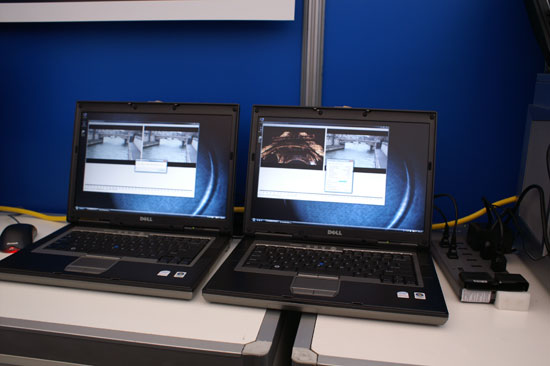
The notebooks, identical Dells with different CPUs, Penryn left, Merom right
The two systems were configured as follows:
| Laptop System Configuration | ||
| Penryn System | Merom System | |
| CPU | 2.80GHz, 800MHz FSB 6MB L2, dual-core |
Core 2 Duo T7800, 2.60GHz, 800MHz FSB 4MB L2, dual-core |
| System | Dell Latitude D830 | Dell Latitude D830 |
| Graphics | Intel GMA X3100 | Intel GMA X3100 |
| Graphics Driver | Intel 7.14.10.12.53 | Intel 7.14.10.12.53 |
| Memory | 2 x 1GB Hynix DDR2-667 | 2 x 1GB Hynix DDR2-667 |
| Hard Drive | Fujitsu MHW2080BH 80GB 5400RPM |
Fujitsu MHW2080BH 80GB 5400RPM |
| OS | Windows Vista Ultimate 32-bit | Windows Vista Ultimate 32-bit |
And the results:
| Laptop Performance Results | ||
| Penryn System | Merom System | |
| TMPGEnc 4.0 Express 4.3.3.9999 Beta (seconds, lower is better) |
151 | 239 |
| DivX 6.6.1 w/ VirtualDub 1.7.2 (seconds, lower is better) |
20.5 | 38.9 |
Since both benchmarks take advantage of SSE4, the Penryn performance improvement is significant. We'd expect overall performance improvement to be closer to what we saw in our Wolfdale preview. The power savings courtesy of Intel's 45nm process will be particularly important in notebooks as it directly impacts battery life, so we should see an added benefit of Penryn there. Do keep in mind that mobile-Penryn won't hit until next year, while the desktop Core 2 Extreme QX9650 will be available starting November 12.
Intel's 8-core SkullTrail System
Intel also had its SkullTrail system up, running, and ready to be benchmarked. SkullTrail features two LGA-771 sockets, accepting a pair of special unlocked Penryn processors that use the Xeon socket but have the same core as the desktop processors. According to Intel, with the Core 2 based processors there are slight differences in the hardware prefetchers in Xeon vs. desktop Core 2 parts and thus it is important to distinguish the SkullTrail CPUs as being Yorkfield based (desktop Penryn) and not Harpertown (server Penryn).
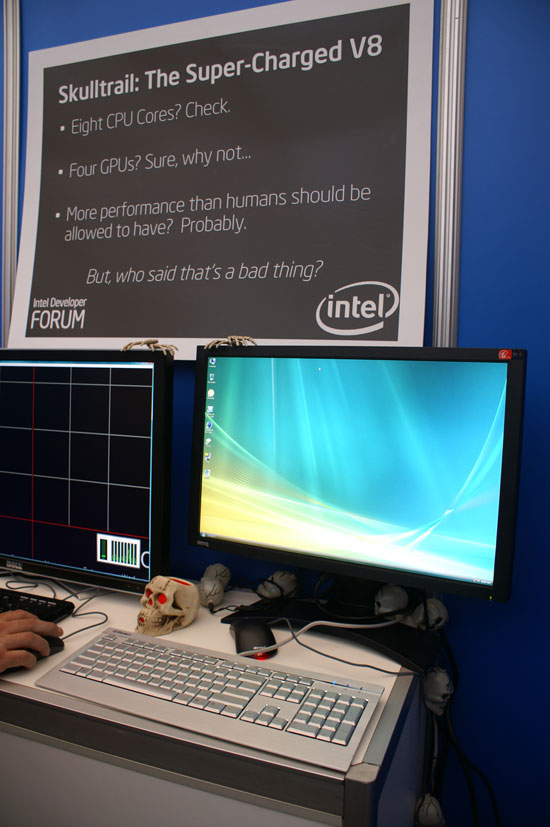
The SkullTrail motherboard actually supports NVIDIA's SLI, which is apparently made possible by actually using a pair of NVIDIA MCPs on the motherboard itself. This isn't an SLI licensing deal; this is Intel purchasing NVIDIA MCPs and using them on its motherboard. 2-way SLI is supported today and Intel claims eventual support for up to 4-GPU SLI, depending on whenever NVIDIA releases drivers and product.
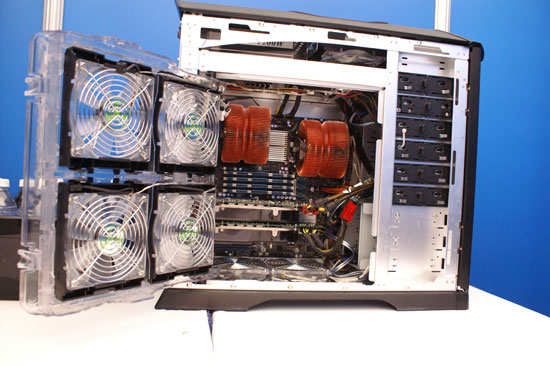
The memory technology is still FB-DIMM unfortunately, but the speeds have been bumped from V8 to DDR2-800 now. The motherboard also offers support for a 1600MHz FSB, and the CPUs installed ran at 3.40GHz (quad-core, 12MB L2, two physical chips).
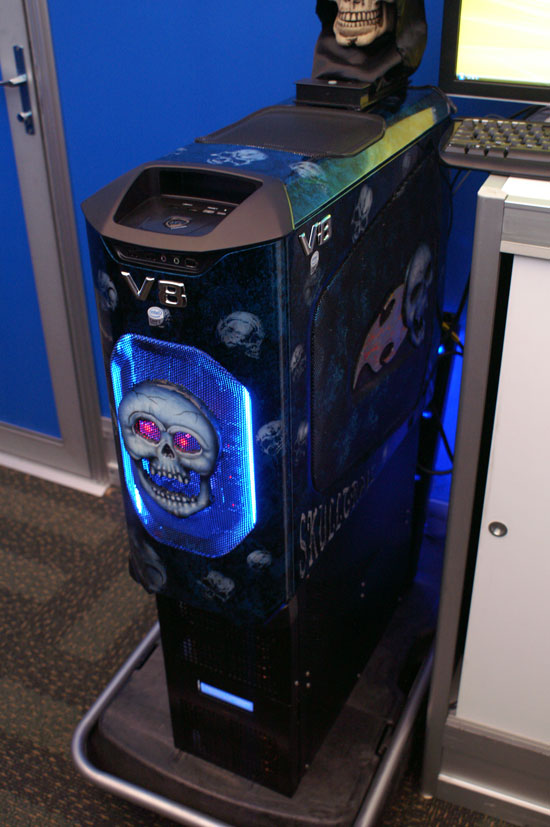
With a total of eight cores there aren't that many desktop benchmarks you can run and actually get good scaling, but Intel managed to pick some that did. The comparison system is a single-socket, quad-core Yorkfield/Penryn on an Intel X38 motherboard running at 3.0GHz/1333MHz FSB. The other key system difference is that the Yorkfield system only has a single GeForce 8800 GTX while the SkullTrail system has two, because it can support them. Intel also outfitted the Yorkfield with 2GB of memory while the SkullTrail had 4GB of memory; while the SkullTrail system should be faster regardless, it wasn't a fair fight from the get-go.
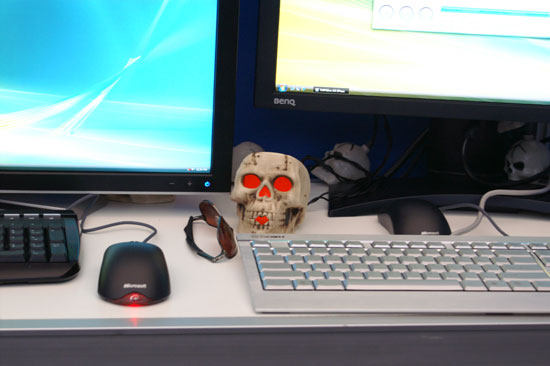
Oh look, Skulls, clever.
| Desktop System Configuration | ||
| SkullTrail System | Yorkfield System | |
| CPU | 2 x quad-core 3.4GHz 1600MHz FSB, 12MB L2 |
1 x quad-core 3.0GHz 1333MHz FSB, 12MB L2 |
| Motherboard | SkullTrail dual socket | Intel X38 |
| Graphics | 2 x GeForce 8800 GTX | 1 x GeForce 8800 GTX |
| Graphics Driver | NVIDIA pre-production driver | NVIDIA 162.22 |
| Memory | 2 x 2GB Micron DDR2-800 CL5 FB-DIMMs |
2 x 1GB Corsair CM3X1024-1333C9DHX |
| Hard Drive | Seagate Barracuda 320GB 7200.10 7200RPM |
Seagate Barracuda 320GB 7200.10 7200RPM |
| OS | Windows Vista Ultimate 32-bit | Windows Vista Ultimate 32-bit |
While we will report the 3DMark '06 numbers we ran during our time with the system, it's not entirely a CPU comparison given the dramatic difference in GPU configurations. However, the CPU tests within 3DMark do generally place the majority of the load on the CPU, while the 3D results (which we're not reporting) heavily stress the GPU(s). However, Cinebench and TMPGEnc show pure CPU-crunching 4-to-8 core CPU scaling.
| Desktop Performance Results | ||
| SkullTrail System | Penryn System | |
| 3DMark 06 V1.1.0 Pro - CPU (score, higher is better) |
6359 | 4569 |
| 3DMark 06 V1.1.0 Pro - Overall (score, higher is better) |
17006 | 11899 |
| Cinebench R10 Beta (CPU benchmark, higher is better) |
21672 | 11810 |
| TMPGEnc 4.0 Express 4.3.3.9999 Beta (seconds, lower is better) |
53 | 72 |
Cinebench R10 performance virtually doubles, while there's a 26% reduction in encoding time in TMPGEnc. If you have the applications to take advantage of it, SkullTrail will give you 8 cores today instead of waiting until sometime in 2008/2009 for octal-core Nehalem.
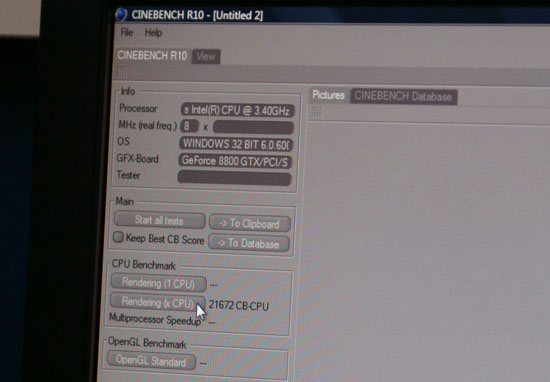
We're not particularly sold on SkullTrail or any of these enthusiast-class dual socket systems (e.g. QuadFX, Intel V8), the performance is there but we're not sure the usage models are. They may be perfect for workstation users who also want to game on their machines, but other than that specific market we don't see much of a need for even the most demanding enthusiasts. Stressing four cores is tough enough most of the time, making the argument for eight at the sacrifice of price, power and noise is a difficult one.

Another skull, clever-er







